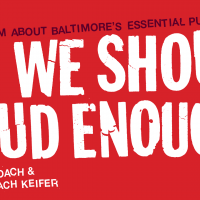
I never saw Double Dagger. If I didn’t regret that before, I certainly do now. I’ve just seen Gabriel Deloach and Zach Keifer’s documentary If We Shout Loud Enough, which focuses on the final tour of this Baltimore punk trio. If We Shout Loud Enough, which is being packaged with the group‘s final record 333 for Record Store Day, uses the group’s final string of shows to deliver an intimate portrait of the Baltimore punk scene — and to document the evolution of a band from a conceptual project to something that has become far more enduring.
The documentary opens in the group’s van, their last tour having just begun. There’s a weary tone present here: the kind of fatigue that comes from long drives already completed and the promise of longer drives to come. The band — Nolen Strals, Bruce Willen, and Denny Bowen — volleys around the answers to some interview questions, in one instance seeking to rework the question ever-so-slightly. There are memories summoned up by questions about preferred food on tour; anecdotes are related ab0ut currywurst in Vienna and New Brunswick’s grease trucks. Still, the tone of this scene seems worrisome: is this going to be a Meeting People is Easy-esque account of rock-tour malaise?
Soon afterwards, the answer to that question becomes clear: absolutely not. And also: see you in the pit.
If We Shout Loud Enough abounds with gripping live footage: Strals repeatedly leaps into crowds, while Willen and Bowen remain frantic presences on stage. Some of the film’s collages of live performances, especially a stunning rendition of More‘s “Vivre Sans Temps Mort,” the song from which the film takes its title. And given the group’s inherent connection to graphic design — members of Double Dagger run Post Typography, and early songs referenced CMYK and fonts — it’s not surprising that the opening credits are particularly striking, evoking a blend of Terry Gilliam’s Monty Python animation and Aaron Cometbus’s copier-gradient aesthetic.
Large sections of If We Shout Loud Enough focus on process, whether the band’s members talking about how certain instrumental techniques evolved to a long section in which Strals screams unadorned into a microphone. There’s also a great deal of focus on the band’s flyers and, in some cases, the ways in which they were created. One segment looks at the way in which an iconic image of The Beatles was transformed into something decidedly more — for lack of a better word — phallic. That leads to an anecdote about downloading potentially illicit material on a former boss’s computer; one is left impressed with the odd stories this band has to tell.
Baltimore writer Tim Kabara narrates the film, toting a portable record player around to various Baltimore spaces. His wry narration, constantly on the verge of winking, is a kind of parody of overly formal narration — and yet, it serves to get abundant information across about both Double Dagger’s history and their place within Baltimore’s DIY scene. Numerous Baltimore alt-culture types also weigh in, including Atomic Books owner Benn Ray, and Dan Deacon. It’s Deacon who most aptly describes Double Dagger’s sound: “It’s not art-school music, but it’s certainly not hardcore.”
But it’s easy to see its appeal to fans of both — that blend of irreverence, raw power, and cerebral focus. The film builds to a climax at Double Dagger’s last show. “We’re Double Dagger, from Baltimore, Maryland,” Strals says, and the crowd assembled at Ottobar lets loose with a roar of approval. If We Shout Loud Enough makes a fine case for the importance of Double Dagger to their local scene, and their music’s overall appeal. “Go home,” Strals says as their final show has ended with leaps into the crowd and a seemingly endless drum break. “Start your own band.” After watching If We Shout Loud Enough, you may well be tempted to.
Follow Vol. 1 Brooklyn on Twitter, Facebook, Google +, our Tumblr, and sign up for our mailing list.

